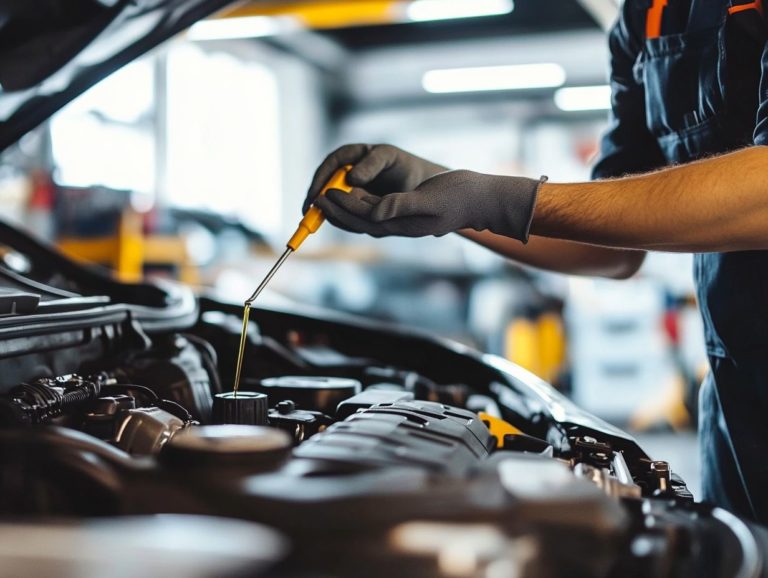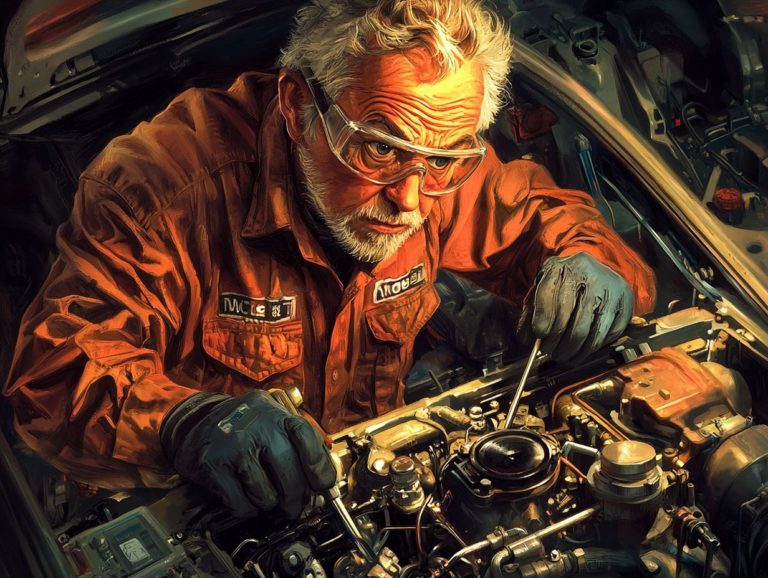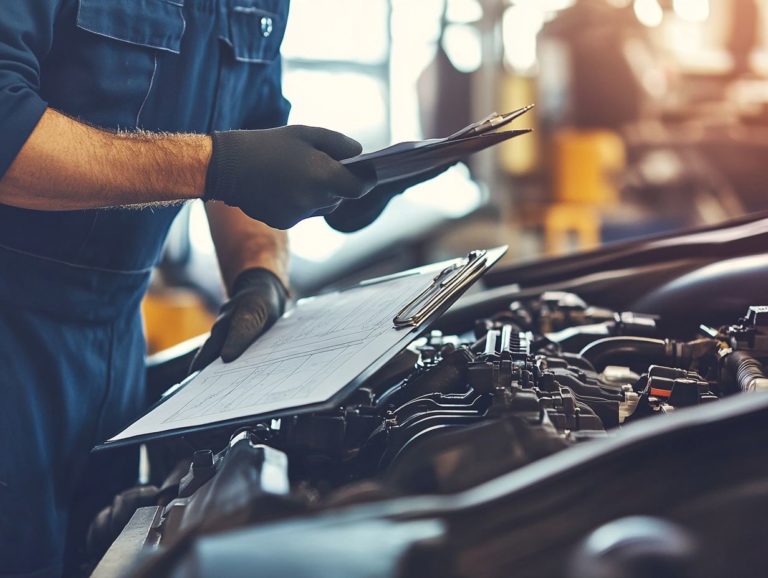Tips for Maintaining Older Vehicles
Maintaining an older vehicle may seem daunting. However, regular upkeep is crucial for its longevity and performance.
From routine oil changes and fluid checks to tire and brake inspections, these maintenance tasks should be high on your priority list. This guide illuminates common maintenance tasks, steps to prevent problems, and insights on how to tackle typical issues that come with aging cars.
You’ll also discover when it might be wise to consider replacing your vehicle or exploring alternatives to purchasing new. Whether you’re a seasoned car enthusiast or a first-time owner, these tips will empower you to keep your older vehicle running smoothly for years to come.
Contents
- Key Takeaways:
- Common Maintenance Tasks for Older Vehicles
- Preventive Measures for Extending Vehicle Lifespan
- Addressing Common Issues with Older Vehicles
- When to Consider Replacing an Older Vehicle
- Frequently Asked Questions
- What are some essential tips for maintaining older vehicles?
- How often should the oil be changed for an older vehicle?
- What are some signs that an older vehicle needs a tune-up?
- Is it important to keep up with regular maintenance for older vehicles?
- What are some ways to extend the life of an older vehicle?
- How can I make sure my older vehicle is safe to drive?
Key Takeaways:

- Regular maintenance is crucial for extending the lifespan of older vehicles and avoiding costly repairs.
- Simple tasks like oil changes, tire and brake inspections, and protecting against rust can greatly impact the longevity of an older vehicle.
- Addressing common issues and knowing when to consider replacing an older vehicle can save time, money, and ensure safety on the road.
The Importance of Regular Vehicle Maintenance
Regular maintenance is essential for classic vehicles; it guarantees reliable starting power and extends their lifespan. This enhances your driving experience and saves you money in the long run.
Whether you’re the hands-on type who loves DIY projects or someone who prefers the expertise of a skilled mechanic, consistent car maintenance allows you to spot potential issues before they turn into larger headaches. This ensures peak performance and safety on the road.
Routine tasks, like oil changes and fluid checks, are vital for keeping these timeless machines in prime condition. If you overlook these straightforward procedures, you risk engine wear or other critical failures, leading to costly repairs that could have been easily avoided.
Comprehensive inspections catch irregularities, from brake wear to electrical hiccups. Partnering with a trusted mechanic who understands classic vehicles is crucial for accurate diagnostics and personalized care.
Make sure your vehicle is properly insured to add protection against potential setbacks as you cruise down the open road.
Common Maintenance Tasks for Older Vehicles
Common maintenance tasks for older vehicles encompass essential activities like oil changes, fluid checks, regular inspections, and tire upkeep. For those driving high-mileage cars, learning how to maintain a car with high mileage can significantly enhance the longevity and performance of your classic vehicle.
By ensuring that all components brakes, coolant levels, and more are functioning optimally, you maintain the quality of replacement parts, ultimately boosting reliability and driving enjoyment.
Oil Changes and Fluid Checks
Oil changes and fluid checks are essential elements of your car maintenance routine. They ensure that your engine operates safely and efficiently while preventing unnecessary wear and tear on valuable replacement parts.
Regularly changing your oil helps maintain optimal engine performance by keeping the oil clean and effective. Checking other critical fluids can help you spot potential leaks or issues before they escalate.
For classic vehicles, it’s typically advisable to change the oil every 3,000 to 5,000 miles, depending on your car use and the type of oil you choose. Opting for high-quality, vehicle-specific oils like multi-grade or synthetic blends can significantly enhance your engine’s longevity.
Maintaining optimal levels of transmission fluid, brake fluid, and coolant is crucial. Neglecting these fluids can lead to overheating, compromised braking, or even a complete breakdown. By prioritizing thorough fluid checks alongside regular oil changes, you can avoid costly repairs and keep your classic vehicle in peak condition for years to come.
Start your maintenance routine today and enjoy the drive!
Tire and Brake Inspections

Tire and brake inspections are vital for ensuring safety and performance in your classic vehicle. They directly impact your car’s handling and stopping power. Regular tire maintenance is essential. Check tire pressure and tread depth regularly. Ensure thorough brake checks to guarantee everything is functioning properly. This proactive approach significantly reduces the risk of accidents.
To keep your vehicle performing its best, make it a habit to rotate your tires regularly, ideally every 5,000 to 7,000 miles. This encourages even wear. Proper alignment is crucial as well; it enhances driving efficiency and extends the life of your tires.
Don’t overlook brake components. Routinely checking pads, discs, and brake fluid levels can prevent dangerous malfunctions. Opting for high-quality replacement parts is just as important, as using inferior options could jeopardize safety and longevity.
Make these maintenance steps a priority to ensure your driving experience is smooth and safe!
Preventive Measures for Extending Vehicle Lifespan
Implementing preventive measures is crucial for extending the lifespan of your classic vehicle. This ensures it remains in peak condition for years to come. Regular inspections play a pivotal role. They help you identify potential issues before they escalate.
Invest in proper rust and corrosion protection to enhance durability. This safeguards your prized possession against the elements.
Protecting Against Rust and Corrosion
Protecting against rust and corrosion is essential for maintaining the integrity of classic vehicles. Exposure to moisture and road salt can cause significant damage over time. Regular inspections and applying protective coatings are vital. This ensures your car remains in prime condition.
Consistently washing your vehicle removes harmful debris and salts that can accumulate, especially during harsh winter months. Applying wax enhances shine and adds a layer of protection against the elements. This creates a barrier your classic car will appreciate.
For those dedicated to keeping their prized rides pristine, using products that prevent rust offers extra defense. It’s crucial to inspect key areas like wheel wells and undercarriages, where rust often appears first. By identifying and addressing potential corrosion early, you can save significant repair costs in the future.
Regular Cleaning and Detailing
Regular cleaning and detailing are essential practices. They elevate the aesthetic appeal of your classic vehicle and safeguard its components from deterioration. A thorough interior detail combined with exterior cleaning maintains your vehicle’s value while preventing long-term damage from dirt and grime.
Your effective cleaning routine should involve vacuuming and shampooing upholstery to remove stains and odors. Applying protectants helps shield against fading and wear. For the exterior, wash regularly to remove contaminants. Waxing not only achieves a brilliant shine but also creates a protective barrier against the elements.
Using premium detailing products like a special type of protective layer for your car’s paint and metal polishes is key to preserving your vehicle s finish and luster. This approach allows you to enjoy your investment while extending its longevity.
With the right techniques and products, maintaining your classic vehicle transforms from a mere task into a fulfilling passion that rewards you in both appearance and performance.
Addressing Common Issues with Older Vehicles
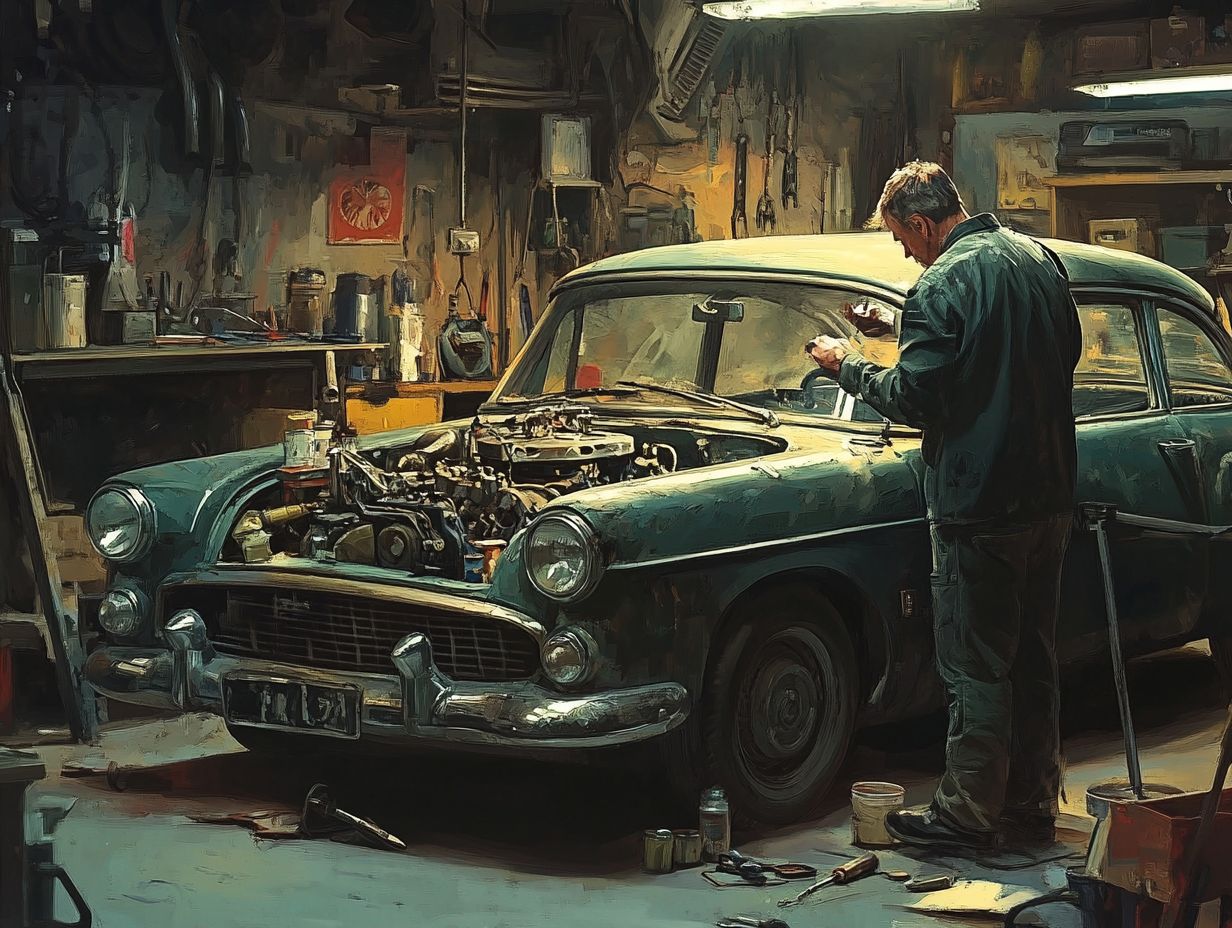
Addressing common issues with older vehicles is essential for maintaining their longevity and performance. To ensure your car stays in top shape, consider following the top 10 car maintenance tips for longevity. These problems can escalate significantly if left unchecked.
Engaging a skilled mechanic for regular inspections helps identify potential issues early. This enables timely and effective repairs that preserve the integrity of your classic vehicle.
Identifying and Fixing Common Problems
Identifying and fixing common problems in classic vehicles demands a discerning eye and a solid grasp of automotive mechanics, which is why a skilled mechanic is absolutely critical. From diagnosing engine issues to tackling electrical components and fluid leaks, prompt repairs can save your vehicle!
Classic vehicles often present symptoms like unusual noises during operation, fluctuating temperatures, or unresponsive electrical systems. Regular diagnostics can catch these issues early, allowing you, the enthusiast, to address minor problems like tightening loose connections or replacing worn spark plugs before they escalate.
If you encounter tricky problems, such as transmission failure or severe rust damage, seeking professional assistance becomes essential. Familiarizing yourself with your vehicle s manual is wise, as understanding its nuances can provide invaluable insights that make the journey of restoring and preserving these automotive gems all the more rewarding.
When to Consider Replacing an Older Vehicle
Knowing when it s time to think about replacing an older vehicle is an important choice that requires careful evaluation of several factors. Consider its overall condition, the cost of repairs, and the accessibility of reliable mechanics.
Classic vehicles often have sentimental value. It s vital to assess their reliability and regular maintenance needs. This thoughtful analysis will empower you to make an informed choice about whether to replace or restore your cherished ride!
Factors to Consider and Alternatives to Buying a New Vehicle
When you re considering replacing an older vehicle, a multitude of factors come into play financial considerations, sentimental value, and alternatives that could extend the life of your classic ride. Instead of rushing to buy a new vehicle, think about exploring options like restoration, upgrading components, or investing in high-quality replacement parts. This approach can be a more cost-effective solution.
You might be surprised to learn that even simple modifications or tuning can enhance fuel efficiency and significantly reduce operating costs over time. It s essential to consult with a trusted mechanic during this process; their expertise can help you make informed choices, ensuring that your investments yield maximum returns.
This professional insight can pinpoint parts worth refurbishing or suggest modern upgrades that maintain your vehicle s character while boosting performance. By thoughtfully weighing these options, you can make strategic decisions that balance your emotional attachment with practical needs.
Frequently Asked Questions
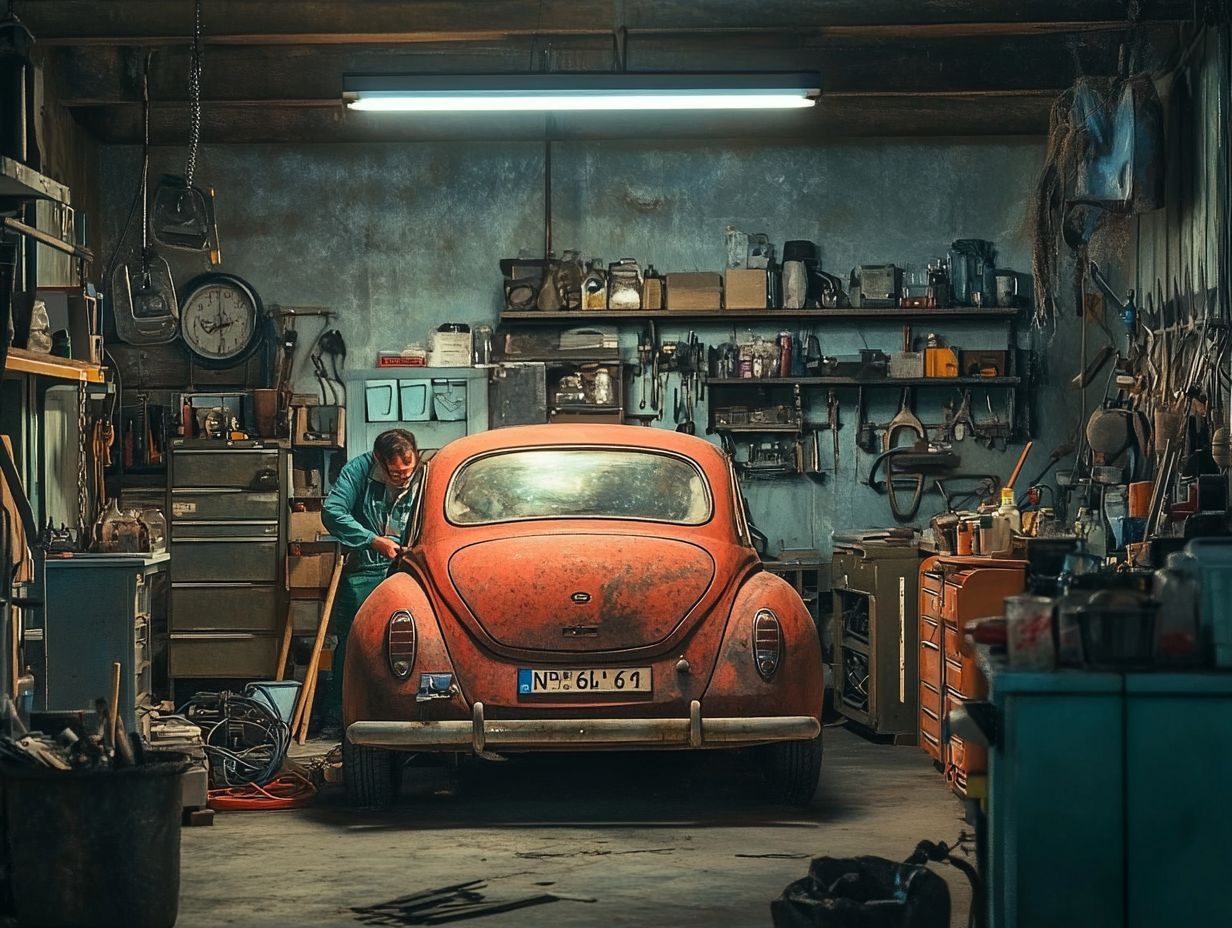
What are some essential tips for maintaining older vehicles?
Regularly change the oil and oil filter, check and replace worn-out belts and hoses, and keep the tires properly inflated. For more guidance, consider these tips for maintaining a family vehicle, as they are important for keeping older vehicles in good condition.
How often should the oil be changed for an older vehicle?
Change the oil every 3,000 to 5,000 miles for the best results, as older vehicles may not efficiently burn oil like newer models.
What are some signs that an older vehicle needs a tune-up?
Some signs include difficulty starting the engine, poor fuel economy, and rough idling. It is recommended to get a tune-up every 30,000 miles for older vehicles.
Is it important to keep up with regular maintenance for older vehicles?
Yes, regular maintenance is crucial for older vehicles to keep them running smoothly and to prevent major issues. For those looking for efficient solutions, consider these 5 tips for quick common car repairs that can help avoid costly repairs.
What are some ways to extend the life of an older vehicle?
In addition to regular maintenance, following tips on how to maintain a classic car over time, such as driving with a light foot, avoiding sudden stops and starts, and using the recommended fuel can help extend the life of an older vehicle.
How can I make sure my older vehicle is safe to drive?
Regularly check and replace worn-out brakes, steering and suspension components, and lights to ensure the safety of your older vehicle. For those new to car care, following the top 10 car maintenance tips for beginners can be incredibly helpful. Pay attention to any unusual noises or warning lights and address them promptly.
For more information, check your vehicle regularly or consult a mechanic!


